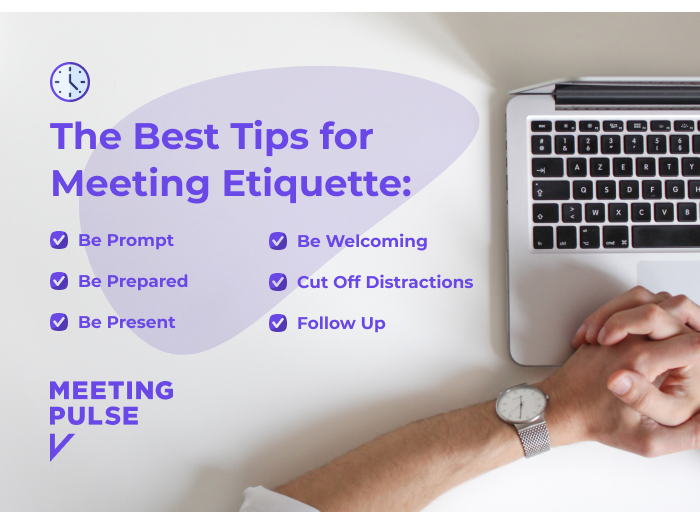In the right environment, meetings can be perfect for solving problems, building teams and unearthing great ideas. If attendees don’t practice meeting etiquette, though, your meetings might become known for unforgettable faux pas and wasting time.
Following meeting etiquette rules helps your teammates communicate and collaborate in a manner that doesn’t ruffle any feathers. But proper meeting etiquette can change, depending on the meeting itself — especially if it’s a hybrid meeting.
In this article, we’ll discuss some etiquette rules that can help make your meetings memorable for all the right reasons.
Be prepared
Like many aspects of life, it’s essential for a meeting organizer and all participants to be prepared before the event begins.
Meeting leader
Sending an agenda to attendees. Create and distribute live meeting agenda to all attendees ahead of time. It should clearly communicate the purpose of the meeting and outline start and finish times. If the meeting is in person, identify which meeting room will be used. For any hybrid or virtual meetings, ensure the correct information about how to log on has been shared.
Set some ground rules. Communicate any meeting policies you’d like attendees to follow. Your rules probably should include the use of mobile devices, cell phones and laptops, side conversations, snacking, and the way people treat each other.
Participant
Ask for an agenda. If you haven’t received an agenda, ask for one. Read it before the meeting takes place, and if any prep work is needed, make sure you complete it. Look for any meeting rules and be sure to follow them. If you’re attending in person, make sure you know where to go so that you can get there on time.
Virtual tip: If you’re working remotely, make sure you’re in a quiet space and your background is free and clear of any distractions or anything that could make other attendees uncomfortable. Let anyone in your living space know when you will be in a meeting so they can avoid causing disruptions.
Be prompt
No one likes to be kept waiting, especially when it comes to business meetings.
Meeting leader
Start on time. This is just good common courtesy. Make sure you start at the appropriate time and respect your colleagues’ schedules.
Participant
Be early. We’re not talking 20 or 30 minutes early, here. Being in the right room or logged into a virtual meeting five minutes early is good business meeting etiquette (and virtual meeting etiquette).
Virtual tip: Use at least one meeting notification that alerts you 5 or 10 minutes before the start time. People on site must leave their desks and walk to a meeting location. Anticipation of the meeting cues them to address some general needs before they head over. They see other people begin their pre-meeting rituals. This includes restroom breaks, grabbing a coffee, getting any notes or prep work together, and checking their appearance in a mirror. Lacking these cues, remote attendees can be caught off guard and click into a meeting exactly when it’s set to begin or even late. They jump in feeling distracted and not in the right frame of mind.
Be welcoming
Aside from being prepared ahead of time, make it a priority to create a welcoming environment that makes every meeting participant feel included and respected.
Meeting leader
Introduce new attendees. If there are any new faces in the group, start by making introductions. Use inclusive tools or policies and icebreakers to put the entire group at ease and create a comfortable, open environment. Use good eye contact as best you can with any virtual attendees.
Participant
Say hello. Greet your colleagues when the meeting begins, especially any remote employees. It’s a great way to make everyone feel directly involved and part of the team. Make sure you’re giving way to any remote speakers. It can be easy to interrupt remote attendees if there is a slight audio delay.
Virtual tip: Staying alert will ensure that if someone greets you or speaks directly to you, you’re ready to respond.
Cut off distractions
What we don’t want to do is leave any background factors open to derail a productive meeting. Paying attention to the details beforehand can keep this from happening.
Meeting leader
Follow your own rules. Yep, it’s that easy. You made rules for the meeting attendees, so you also need to stick to them. Resist any urge to pick up your cell phone or answer an email while you’re hosting the meeting.
Participant
Mute phones and disable notification noises. Think of how distracting your own phone buzzing in the background can be for you. Now consider how jarring it might be to others. Make sure your phone is on silent — even quiet noises can be disruptions. If you’re using your laptop during the meeting, turn off any audible notifications, too.
Virtual tip: Consider using a blur effect or false background as needed so attendees aren’t distracted by your surroundings. Consider setting up your camera in a way that avoids catching any roommates or pets walking into view. And absolutely avoid leaving the room in the middle of the meeting.
Mute
Noise happens, even when we try to prevent it.
Meeting leader
Set the standard. This can be a bit tricky for you, unfortunately. If you’re leading a meeting in person and have virtual attendees, you could mute your mic while any remote colleagues are speaking so you don’t disrupt them. If your whole group is on a virtual call, you can mute your mic whenever anyone else is speaking.
Participant
Get familiar with the mute button. It’s a good idea to keep yourself on mute until you need to speak.
Virtual tip: Keeping yourself on mute is best practice, but make sure you unmute yourself when you actually need to say something. Don’t be that person who still must be told, for the hundredth time: “You’re still on mute.” Then, speak loudly so that everyone can hear you.
Side chatter
Though it might be tempting, side chatter can be more distracting than helpful.
Meeting leader
This should be easy. It’s not a good look for a meeting leader to be making asides. You want to practice active listening throughout the duration of the meeting. Side chatter makes that a tall order.
Participant
Stay on point. Similarly, you’ll need to actively listen to make sure you’re not missing any key information. It’s best to limit side chatter to absolute necessity.
Virtual tip: If a chat function is available during a virtual meeting, use it as necessary, but don’t stray off topic.
Be present
There are many things to be avoided here, like doing any side work and refraining from eating and drinking.
Meeting leader
Be creative, too. This goes back to the idea of active listening, which helps you stay focused and connected with your team. For long meetings, take short breaks and use icebreakers, live polling or surveys to keep your team members interacting.
Participant
Hand-in-hand. Among the many benefits of active listening is that it requires you to stay in the moment. Staying engaged and keeping your ears open also opens your mind and creativity to new ideas and approaches.
Virtual tip: Make sure you’re dressed properly. Proper attire can remind you that you’re participating in a professional space even when you’re not seated in one. And pay attention to your body language. Avoid the temptation to work on other things while the meeting goes on in the “background.”
Communicate
It is difficult to accomplish anything at a meeting if your group doesn’t communicate effectively.
Meeting leader
Expend the energy. These gatherings are an opportunity for you to shine. There will be teachable moments and openings for you to help your team members grow. Make all that prep work pay off. Look for ways to directly engage attendees, especially virtual colleagues. Speak specifically to them to draw them in. If you find that one or two voices are dominating the conversation, ask questions periodically of those who aren’t speaking to give everyone a chance to contribute.
Tools to Use:
- Live Polls, Surveys, and Quizzes
- Q&A Sessions
- Idea Brainstorming
- Crowdsourced Agendas
- Live Sentiment Analysis
- Chat
- Anonymity for participants (for honesty and psychological safety)
Participants
Promote psychological safety in meetings and events. When you begin to offer your thoughts, especially in response to others, stay on the topic and avoid straying from the agenda. Keep your focus on building up your colleagues. Ask questions at the appropriate times and do your best not to interrupt the conversational (and ideational) flow, especially with criticism or body language like head-shaking or negative facial expressions.
Virtual tip: If there is a “raise hand” function on your meeting platform, use it to indicate you have something to say. It is all too easy to hold back when you aren’t in the room. Avoid that temptation. If there is no “raise hand” function, try the chat function to indicate that you would like to speak. Or, simply unmute yourself and wait for a break in speech to jump in.
Follow up
It’s always a good idea to check in with the attendees of your last meeting relatively quickly.
Meeting leader
Send out a meeting effectiveness survey. During the meeting itself is the best time to send people a link to a meeting survey. Participation will be much higher during the event than after.
Send out a post-meeting note. It should summarize any key decisions or responsibility changes, and make sure your team understands any assignments.
Send “thank you’s” or other acknowledgements. If you had any guest speakers or celebratory moments, take a minute to say thank you or put the spotlight on anything noteworthy.
Participant
Complete your tasks. Pick up any new assignments? Make sure you get them done in a timely manner after the meeting.
Virtual tip: If any links or materials were distributed during the meeting, make sure to save those right away. When you need the information again, you’ll be glad to have it on hand.
At meeting’s end
Meetings can be tough, but these meeting etiquette tips can make them more manageable. MeetingPulse has a variety of tools and etiquette tips to help you turn your meetings from boring to brilliant.






